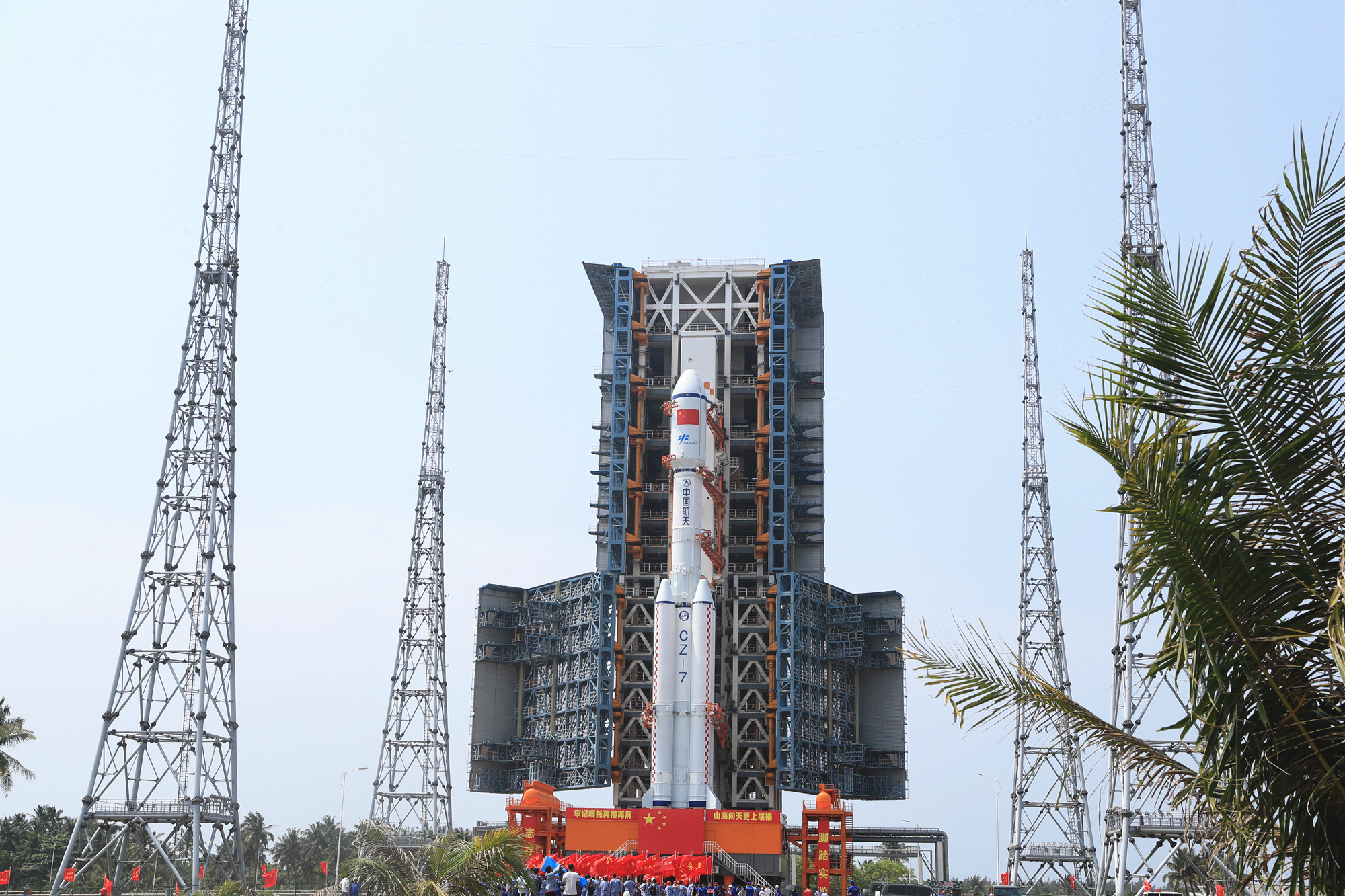
Deutsch-Chinesische Enzyklopädie, 德汉百科
 China
China

中国文昌航天发射场[2](China Wenchang Spacecraft Launch Site),又称文昌航天城,位于中国海南省文昌市龙楼镇以南、中南水库以东,隶属中国西昌卫星发射中心,是西昌卫星发射中心下辖的两个发射场之一。[3][4][5]
该航天发射场于2009年9月14日开工建设,2014年10月中旬建成。由于此地点的纬度较低(约北纬19度),离赤道较近,地球自转造成的离心力可以让火箭在燃料不变的情况下携带更大的载荷。该中心可以用来发射大型长征五号系列火箭及中型长征七号系列火箭。
文昌衛星発射場(ぶんしょうえいせいはっしゃじょう、簡体字: 文昌卫星发射场、英語: Wenchang Satellite Launch Site)は、中華人民共和国海南省の文昌市郊外のロケット発射場、西昌衛星発射センターに所属。南シナ海に面した海南島の北東の海岸に位置する中国第4の発射場で、4つの発射場のうち最も南にあり、中国初となる海岸沿いの発射場。もとは弾道ロケットの試験場だった場所であるが、本格稼働に向け拡張工事が行われている。
Wenchang Spacecraft Launch Site (文昌航天发射场[2][3]), located in Wenchang, Hainan, China. It is one of the two spacecraft launch sites of Xichang Satellite Launch Center (the other site is in Xichang).[4][5][6]
It is a former sub-orbital test center. It is China's fourth and southernmost space vehicle launch facility (spaceport). It has been specially selected for its low latitude, which is only 19 degrees north of the equator, which will allow for a substantial increase in payload, necessary for the future manned program, space station and deep space exploration program. Furthermore, it is capable of launching the new heavy-lift Long March 5 booster.[7]
Unlike the space centers on the mainland whose rail tracks are too narrow to transport the new five meter core boosters, Wenchang uses its sea port for deliveries. Initial launches of the CZ-5 booster from Wenchang were, as of early 2008, expected in 2014, one year after the intended commissioning of the Wenchang Launch Site.[8] They were later shifted to 2016.[9] The CZ-5B (max payload to LEO) variant will fly around 2018.[10] But CZ-5 carrier rocket was already shipped from North China's Tianjin port at 20 September 2015 for a rehearsal (some drills carried out on the launch pad that involves both the carrier rocket and a probe) of a scheduled Chang'e-5 lunar mission planned around 2019.[11]
The construction of the site was completed by October, 2014.[1] The first launch took place successfully at 20:00, June 25, 2016.[12]
La base de lancement de Wenchang est la quatrième base de lancement d'engins spatiaux de la République populaire de Chine. Elle est entrée en fonction le 25 juin 2016 avec le lancement du premier exemplaire du lanceur lourd Longue Marche 7. Elle est située à proximité de la ville de Wenchang sur la côte nord-est de l’île de Hainan. Utilisé jusque-là pour le tir de fusées-sondes, le site a été sélectionné en premier lieu pour sa faible latitude : situé sur le 19e parallèle nord, sa proximité avec l’équateur permet d’augmenter de manière importante la masse des charges utiles placées sur une orbite géostationnaire. La base est conçue pour permettre le tir des nouveaux lanceurs chinois en particulier le lanceur de moyenne puissance Longue Marche 7 qui doit assurer la majorité des lancements de satellites chinois à terme et le lanceur lourd Longue Marche 5 (charge utile de 25 tonnes en orbite basse) qui doit d'une part jouer un rôle central dans la réalisation du programme spatial habité en permettant la construction d’une station spatiale lourde d'autre part permettre l'envoi de sondes spatiales dans le système solaire.
Il centro spaziale di Wenchang (WSLC, Wenchang Satellite Launch Center) è uno spazioporto situato a Wenchang, sull'isola di Hainan, in Cina. In precedenza usato solo per voli suborbitali, il 25 giugno 2016 è stato utilizzato per la prima volta per un lancio orbitale. È il quarto centro di lancio cinese e quello situato più a sud (19° di latitudine), il che permette di aumentare il carico lanciato senza dover aumentare le dimensioni del lanciatore. Sarà utilizzato per future missioni umane, per la stazione spaziale cinese e per missioni nello spazio profondo. Sarà inoltre il sito di lancio per il futuro lanciatore spaziale cinese Lunga Marcia 5.
Il primo lancio è avvenuto alle ore 20.00 (ora locale) del 25 giugno 2016, quando un lanciatore Lunga Marcia 7 ha portato in orbita con successo alcuni satelliti.
El Centro de Lanzamiento de Satélites de Wenchang (WSLC), ubicado cerca de Wenchang, en la costa noreste de la isla de Hainan, es una base espacial china. Es la cuarta instalación de lanzamiento de vehículos espaciales, y situada más al sur, de la República Popular de China. Ha sido seleccionada especialmente por su baja latitud, que está a sólo 19 grados al norte del ecuador, lo que permitirá un aumento sustancial de la carga útil, necesaria para el futuro programa tripulado, la estación espacial y el programa de exploración del espacio profundo. Además, es el centro de lanzamiento de los nuevos vehículos Larga Marcha 5 (CZ-5).2
A diferencia de los centros espaciales en el continente cuyo ancho de vía es demasiado estrecho para transportar los nuevos vehículos de 5 metros, Wenchang hará uso de su puerto marítimo para las entregas. Los lanzamientos iniciales del CZ-5 se esperan para 2014, un año después de la prevista puesta en marcha del Centro de Wenchang.3
Китайский космодром Вэньчан (кит. трад. 中国文昌航天发射场, пиньинь: Zhōngguó wénchāng hángtiān fāshè chǎng, палл.: чжунго вэньчан хантянь фашэ чан, англ. China Wenchang Spacecraft Launch Site, сокр. WSLC) — четвёртый китайский космодром. Прежнее (до ноября 2016 года) название: Центр запуска спутников Вэньчан[1]. Также известный, как Космический городок Вэньчан. Расположен на острове Хайнань (который ранее был известен курортами), на самом юге Китая. Космодром Вэньчан будет иметь ключевое значение для дальнейшей реализации амбициозной космической программы Китая. Его будут использовать для доставки на орбиту компонентов национальной космической станции и осуществления лунных миссий.

曲水流觞,是中国古代汉族民间的一种传统习俗,后来发展成为文人墨客诗酒唱酬的一种雅事 。夏历的三月上巳日人们举行祓禊(fúxì)仪式之后,大家坐在河渠两旁,在上流放置酒杯,酒杯顺流而下,停在谁的面前,谁就取杯饮酒,意为除去灾祸不吉。这种传统历史非常古老,最早可以追溯到西周初年,据南朝梁吴均《续齐谐记》:“昔周公卜城洛邑,因流水以泛酒,故逸《诗》云'羽觞随流波'。”
“曲水流觞” 主要有两大作用,一是欢庆和娱乐,二是祈福免灾。
曲水流觞,是源于中国的一种游戏,后来流传至日本、朝鲜半岛。夏历的三月人们举行祓禊仪式之后,大家坐在河渠两旁,在上流放置酒杯,酒杯顺流而下,停在谁的面前,谁就取杯饮酒。这种游戏非常古老,逸诗有云:“羽觞随波泛”。
“曲水流觞”源于上巳节这一古老风俗。上巳指夏历三月的第一个巳日。周代有水滨祓禊之俗,祓禊指洗濯身体以除去凶疾的一种祭祀仪式,朝廷指定专职的女巫掌管此事。《诗经·郑风·溱洧》记载有郑国阳春三月祓禊的情景。汉代时三月上巳确定为节日。《后汉书·礼仪志》载:“三月上巳,官民皆禊于东流水上,洗濯祓除,去宿垢,为大洁。”魏晋以后上巳改为三月初三,成为一个重要节日,洗濯身体的风俗逐渐演化成临水宴客和郊外踏春,又有了临水浮卵和临水浮枣等习俗,再演变成流觞曲水。
东晋永和九年(353年)三月初三的上巳节,会稽内史王羲之偕亲朋谢安、孙绰等四十二人,相聚会稽山阴(今浙江绍兴)的兰亭,修禊祭祀仪式后,举行曲水流觞的游戏,四十二人人饮酒咏诗,所作诗句结成了《兰亭集》,王羲之为该集作《兰亭集序》。从此曲水流觞,咏诗论文,饮酒赏景,历经千年而盛传不衰。
 China
China

 Energy resource
Energy resource

 Energy resource
Energy resource
 Onshore and offshore wind farms
Onshore and offshore wind farms

 Energy resource
Energy resource
 *Renewable energy
*Renewable energy
 Erneuerbare Energie
Erneuerbare Energie
 Erneuerbare Energie
Erneuerbare Energie
 Windenergie
Windenergie
 Gansu Sheng-GS
Gansu Sheng-GS





Das Wolong-Naturreservat erstreckt sich über 2000 Quadratkilometer Bergwald und wurde im Juni 1980 vor allem zum Schutz des Großen Pandas eingerichtet, von dessen gesamter Wildpopulation etwa 10 % hier leben. Der WWF stellte für die Einrichtung des Gebiets rund eine Million US-Dollar zur Verfügung.[1] Im Gebiet befindet sich auch eine Forschungs- und Zuchtstation für Große Pandas. Verschiedene Zuchtprogramme haben dort bis 2010 zur Geburt von 86 Panda-Jungen geführt.
Die Zerstörung der natürlichen Lebensräume im Reservat hält an und ist teilweise sogar höher als in angrenzenden Gebieten außerhalb des Schutzgebietes.[2]
Zur Tierwelt des Schutzgebiets gehören neben den Großen Pandas auch Leoparden, Rothunde und kleinere Raubtiere, wie Asiatische Goldkatzen, Katzenbären, Schweinsdachse und Buntmarder. Die Huftiere sind durch Sichuan-Takine, Wildschweine, Moschustiere, Seraue, Gorale, Schopfhirsche und Sambarhirsche vertreten. In den Wipfeln leben Goldstumpfnasen und Flughörnchen (Trogopterus xanthipes), am Boden leben Bambusratten und Stachelschweine.[3] Durch die Temperaturunterschiede, die sich aus den unterschiedlichen Höhenlagen ergeben, und die Lage in einem Übergangsgebiet treffen hier tropische Arten, wie Nebelparder und Sambarhirsche auf nördliche Tiere, wie Weißlippenhirsche, Schneeleoparden und Nordluchse.[4]
四川卧龙国家级自然保护区,是中华人民共和国始建于1963年的一处国家级自然保护区,与全国唯一的县级特别行政区四川省汶川卧龙特别行政区(简称卧龙特别行政区或卧龙特区,原称四川省汶川县卧龙特别行政区)的行政机构合署办公且管辖地域完全重合,位于中国四川省阿坝藏族羌族自治州汶川县西南部,邛崃山脉东南坡,覆盖面积约20万公顷,是大熊猫的主要栖息地之一。同时也是珍贵濒危植物、其它国家级重点保护濒危动物的栖息地。
1980年列入“人与生物圈”保护区网络,同年与世界野生动物基金会合作建立中国保护大熊猫研究中心,也是2006年中国政府向联合国教科文组织申报的世界自然遗产选址之一,结果以四川大熊猫栖息地之名义登入。
经国务院批准,四川省汶川县卧龙特别行政区成立于1983年3月。 1983年7月,四川省人民政府、中华人民共和国林业部决定改其名为四川省汶川卧龙特别行政区,实行与卧龙自然保护区管理局合署办公的管理体制。卧龙特别行政区是中国四川省的一个特殊政区,现有人口5343人,由卧龙镇和耿达乡(行政区划属汶川县)组成,隶属于四川省人民政府,但实际管理则是由四川省林业厅[2]负责。卧龙特别行政区的辖区与自然保护区完全重合,是中华人民共和国境内唯一的一个县级特别行政区。四川省汶川卧龙特别行政区的辖区与四川卧龙国家级自然保护区完全重合,并与国家林业局卧龙自然保护区管理局合署办公。
Wolong National Nature Reserve (simplified Chinese: 卧龙自然保护区; traditional Chinese: 臥龍自然保護區; pinyin: Wòlóng Zìránbǎohùqū) is a protected area located in Wenchuan County, Sichuan Province, People's Republic of China. Established in 1963 with an initial size of about 20,000 hectares, the reserve was further expanded in 1975, covering an area of about 200,000 hectares in the Qionglai Mountains region. There are over 4,000 different species recorded in the reserve.[2] According to China's Third National Giant Panda Survey, Wolong National Nature Reserve houses about 150 wild individuals of highly endangered giant pandas. The reserve is also a home to many other endangered species including: snow leopards, red pandas, golden monkeys, white-lipped deer and many precious plants. Before the devastating 2008 Wenchuan earthquake Wolong got up to 200,000 visitors every year.[3][4] Its area is superseded by the Wolong Special Administrative Region.
La réserve naturelle nationale de Wolong, située dans le Xian de Wenchuan placé sous la juridiction de la préfecture autonome tibétaine et qiang d'Aba, à 130 km de Chengdu, capitale de la province du Sichuan en République populaire de Chine.
La réserve naturelle de Wolong a été fondée en 1963 avant de devenir une réserve de biosphère en 19791. Elle est connue pour son Centre de recherche des pandas géants de Wolong, qui dirige la reproduction et la protection des pandas géants. Elle couvre une superficie d'environ 7 000 km2. Le site abrite environ 300 pandas géants, la moitié d'entre eux est à l'état sauvage, alors que l'on ne recense, en 2007, qu'environ 1 600 pandas géants dans le monde.
En 2004, la réserve et différents centres de recherche ont été couverts par un réseau de télécommunication sans fil qui permet de suivre jour et nuit l'activité des pandas. Cette avancée technique est d'un grand secours pour les chercheurs qui peuvent ainsi éviter de nombreux déplacements et assurer une surveillance discrète des animaux. La réserve a été ajoutée à la liste du patrimoine mondial de l'UNESCO le 12 juillet 20062.
La chasse au panda géant, l'une des espèces les plus menacées au monde, a été interdite officiellement en 1962 en Chine. Wolong a donc été fondée dès 1963, et est devenue la plus grande réserve de pandas géants parmi les 31 de ce type en Chine avec 200 000 hectares consacrés aux animaux. Elle abrite en 2006 154 pandas géants sauvages, soit 10 % du total du pays.
La riserva naturale nazionale di Wolong è un'area protetta situata nello Xian di Wenchuan, posta sotto la giurisdizione della prefettura autonoma tibetana e qiang di Aba, a 130 km da Chengdu, capitale della provincia del Sichuan, nella Repubblica popolare cinese.
La riserva naturale di Wolong venne fondata nel 1963 e nel 1979 venne dichiarata riserva della biosfera[1]. È conosciuta per il suo centro di ricerca sui panda giganti, che gestisce la riproduzione e la protezione degli stessi. Ricopre una superficie di circa 2000 km². Il sito ospita circa 300 panda giganti, metà dei quali vive libera in natura; a dimostrazione della sua importanza, basta ricordare che nel 2007 rimanevano solamente 1600 panda giganti in tutto il mondo.
Nel 2004, la riserva e vari centri di ricerca sono stati coperti da una rete di telecomunicazione senza fili che permette di sorvegliare giorno e notte l'attività dei panda. Questa tecnologia avanzata è di grande aiuto per i ricercatori (che possono così evitare di spostarsi frequentemente), garantendo una sorveglianza discreta degli animali. La riserva è stata inserita nella lista dei patrimoni dell'umanità dell'UNESCO il 12 luglio 2006[2].
La caccia al panda gigante, una delle specie più minacciate del mondo, è stata vietata ufficialmente in Cina nel 1962. Wolong è stata fondata nel 1963, ed è divenuta la più grande riserva di panda giganti tra le 31 di questo genere che esistono in Cina, con 200.000 ettari riservati agli animali. Essa ospitava nel 2006 154 panda giganti selvatici, vale a dire il 10% del totale.
La Reserva Natural Nacional Wolong (chino tradicional: 臥龍自然保護區, chino simplificado: 卧龙自然保护区, pinyin: Wòlóng Zìránbǎohùqū) es un área protegida ubicada en el condado Wenchuan, en la provincia de Sichuan en China. Fundada en 1963, la reserva cubre un área de unas 200.000 hectáreas en la región de las Montañas Qionglai. Existen 4.000 especies diferentes registradas en la reserva.1 Alberga a más de 150 pandas gigantes, una especie altamente amenazada. La reserva es también hogar de muchas otras especies en peligro, incluyendo pandas rojos, langures ñatos dorados, ciervos de hocico blanco y una gran diversidad de plantas. Wolong recibe 100.000 visitantes al año.2
Вэньчуань-Улун (кит. 卧龙自然保护区) — национальный природный заповедник находящийся в уезде Вэньчуань Нгава-Тибетско-Цянского автономного округа китайской провинции Сычуань, входит в состав комплекса охраняемых природных территорий «Резерваты большой панды». Создан в 1963 году, занимаемая площадь: около 200 тысяч гектар. На территории резервата в общей сложности обитает более 4000 биологический видов.





Die Wudang-Berge, heilige daoistische Berge im Nordwesten der Provinz Hubei in Zentralchina gelegen, auch "Heiligstes Gebirge unter dem Himmel" genannt, erstrecken sich über eine Fläche von 400 km.
In dieser schönen Landschaft finden sich 46 Haupttempel und Nonnenklöster, 72 Schreine und zahlreiche Höhlen und Einsiedeleien. Auf verwunschenen alten Steinwegen kann man den höchsten der 72 Gipfel, den 1600 m hohen Berg Tianzhu erklimmen, auf dessen Spitze sich der Goldene Tempel befindet.(Quelle: www.china-spezialreisen.de/wudang.html)
Die Wudang-Berge, Wudang Schan (chinesisch 武當山 / 武当山, Pinyin Wǔdāng Shān, W.-G. Wu Tang Shan, bekannt unter dem Namen „Taihe - 太和“ chinesisch 太和山, Pinyin Tàihé Shān, W.-G. T’ai Ho Shan ‚Berg der höchsten Harmonie / Berg des großen Friedens‘ oder „Xuan Yue“ chinesisch 玄岳, Pinyin Xuán Yuè ‚Berg der Mysterien‘), sind eine Bergregion im Nordwesten der chinesischen Provinz Hubei, nahe der Stadt Shiyan.
Das Gebiet umfasst ca. 400 km² und besteht aus 72 Gipfeln, der höchste mit 1612 m ist der Tianzhu (chinesisch 天柱峰, Pinyin Tiānzhù Fēng ‚Gipfel der Himmelspfeiler‘). Des Weiteren besticht die Landschaft mit 36 bizarren Felsen und 24 Tälern.
Mit seinen zahlreichen Bauwerken, Tempeln, Palästen, Klöstern, Brücken, Toren, Höhlen und Einsiedeleien ist Wudangshan ein berühmter heiliger Platz der daoistischen Religion und Anziehungspunkt für Pilger aus aller Welt.
武当山(ぶとうさん、ウーダンシャン)は、中華人民共和国湖北省十堰市にある山。又の名を太和山という。周囲400km、72峰からなる広大な山で、主峰は天柱峰(標高1612m)。山脈中には道観(道教寺院)群がある。
「玄天真武大帝」を奉る道教武当派と中国武術の武当拳の発祥地。道観は元の時代に戦火で焼失し、明の洪武帝の時代に再建された。道観と建物は1994年にユネスコ世界遺産(武当山古建築)となる。
日本では、映画『グリーン・デスティニー』中に物語の舞台として登場し、広く知られるようになった。
The Wudang Mountains (simplified Chinese: 武当山; traditional Chinese: 武當山; pinyin: Wǔdāng Shān) consist of a small mountain range in the northwestern part of Hubei, China, just south of Shiyan. They are home to a famous complex of Taoist temples and monasteries associated with the god Xuanwu. The Wudang Mountains are renowned for the practice of Tai chi and Taoism as the Taoist counterpart to the Shaolin Monastery,[1] which is affiliated with Chinese Chán Buddhism. The Wudang Mountains are one of the "Four Sacred Mountains of Taoism" in China, an important destination for Taoist pilgrimages.
Les monts Wudang (chinois simplifié : 武当山 ; chinois traditionnel : 武當山 ; pinyin : ; parfois écrit Wutang) ou montagnes de Wudang, sont une chaîne de montagnes au sud de la ville-préfecture de Shiyan dans la province du Hubei, en Chine.
Elle est considérée comme l'un des berceaux des arts martiaux internes taoïstes comme le taiji quan ou le bagua zhang qui se développèrent à partir du XVIIIe siècle. Les monts Wudang sont très connus et visités pour les nombreux monastères taoïstes que l'on peut y trouver. Ces monastères sont réputés comme centres de recherche d'apprentissage et de pratique de la méditation, des arts martiaux et de la médecine traditionnelle chinoise, et des pratiques de l'agriculture et des arts liés au taoïsme.
I Monti Wudang (in cinese: 武当山, Wǔdāng Shān), conosciuti anche col nome di Wu Tang Shan o semplicemente Wudang, sono una piccola catena montuosa che si trova nella provincia di Hubei, in Cina, poco a sud della città di Shiyan. Sono monti sacri e mete di pellegrinaggio per i fedeli taoisti e rappresentano una delle mete più rilevanti per il turismo cinese.
Queste montagne sono luoghi importanti sin dai tempi antichi per la presenza dei numerosi monasteri taoisti che vi si trovano, famosi come centri accademici di ricerca, insegnamento e pratica della meditazione, delle arti marziali cinesi, della medicina tradizionale cinese e delle pratiche e arti connesse all'agricoltura taoista. Già durante la dinastia Han le montagne attrassero l'attenzione dell'imperatore (fra il I e il III secolo). Durante la dinastia Tang (fra il 618 e il 907) venne costruito il primo tempio. Nel 1994 i templi delle montagne Wudang vennero inclusi nell'elenco dei Patrimoni dell'umanità dell'UNESCO.
Nel 1956 una grande quantità di statue antiche raffiguranti divinità e santi vennero fuse. Durante la rivoluzione culturale (1966 - 1976), con la quale venne attuata una capillare destituzione ed eliminazione delle religioni, i templi vennero svuotati, danneggiati, molti distrutti e dimenticati per decenni. Le attività religiose sono riprese di recente con il revival del Taoismo, alcuni templi, ricostruiti o restaurati, stanno tornando attivi e si stanno costituendo nuove comunità di monaci. Alcuni monasteri si sono organizzati in un'associazione, la Chiesa taoista dei monti Wudang. Nel giugno 2005 numerose comunità monastiche e maestri spirituali che si trasferirono in Taiwan per sfuggire alle persecuzioni sono stati autorizzati a fare ritorno presso i templi.
Fra gli edifici, costruiti ed ampliati soprattutto durante la dinastia Ming, si trovano costruzioni risalenti al VII secolo. Il complesso templare ha una grande valenza artistica, in quanto esprime l'apogeo raggiunto dall'arte e architettura cinese in un periodo di circa 1.000 anni.
Los montes Wudang (chino tradicional: 武當山, chino simplificado: 武当山, pinyin: Wǔdāng shān) se encuentran en el noroeste de la provincia de Hubei, en China. Su cumbre principal es llamada Tianzhu (Pilar del Cielo) y destaca entre los 72 picos que la rodean. El Conjunto de edificios antiguos de las montañas de Wudang fueron declarados patrimonio de la humanidad por la Unesco en el año 1994.
Se cree que en estos montes se originaron algunos estilos de artes marciales relacionados con el taoísmo, y se destacan el Wudangquan o Wudai Pai o estilo de lucha Wudang, y otros estilos relacionados, por ejemplo, Pa Kua Chuan, Ba Ji Quan, Tai Chi Chuan, etc. La leyenda atribuye a la región de los Montes de Wudang el origen de los estilos internos de las artes marciales chinas.
Los Montes Wudang destacan por ser el núcleo de templos taoístas y por su tradición histórica de maestros relevantes del taoísmo y de la medicina tradicional china .
Уданшань (кит. упр. 武当山, пиньинь: Wǔdāng Shān, палл.: Уданшань), гора Удан — небольшой горный хребет в провинции Хубэй, который находится недалеко от промышленного города Шиянь и около 120 км от города Сянфань.
Горы Уданшань знамениты своими даосскими монастырями и храмами, здесь был даосский университет, в котором исследовалась медицина, фармакология, системы питания, медитация и боевые искусства.


 Aerospace
Aerospace
 Astronomy
Astronomy
 Science and technology
Science and technology
 History
History
 Sport
Sport
 Animal world
Animal world
 Geography
Geography
 Religion
Religion
 World Heritage
World Heritage